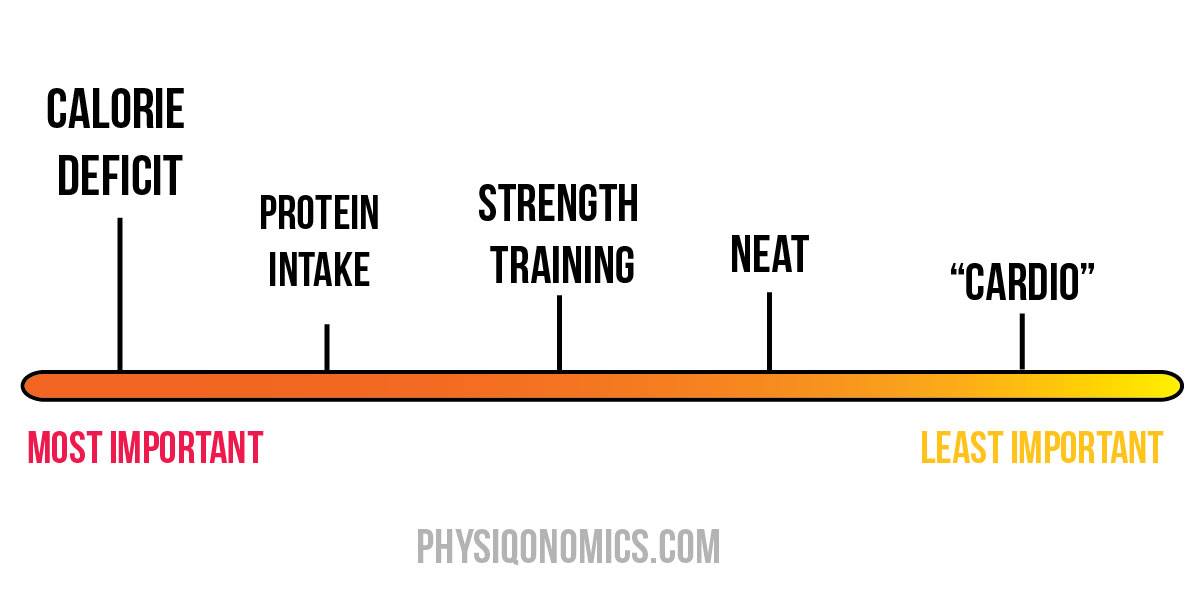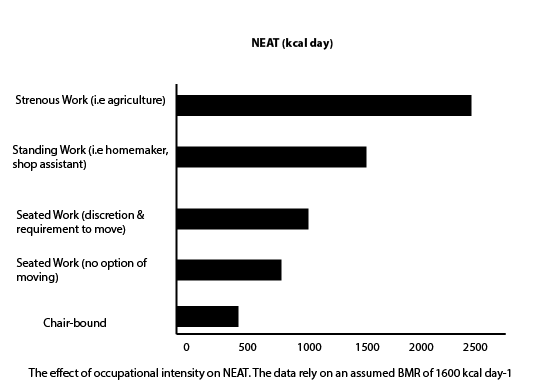Take a look at this image:

It shows the hierarchy of fat loss in the order of importance. A calorie deficit is the most important and cardio comes in right at the end.
This doesn’t mean cardio is bad or pointless–everyone should do some form of cardio; swimming, walking, running, hiking, playing a sport, whatever–the point I’m trying to impress upon you is that most people resort to ‘cardio’ when trying to lose fat but it’s of the least importance when fat loss is the goal.
If you look back at the image, you’ll see that something called NEAT comes before cardio–it’s probably one of the most powerful things you can do when losing fat.
Let’s talk about that.
WTF is NEAT?
NEAT stands for Non-Exercise Activity Thermogenesis and is all the activity that isn’t intentional exercise: fidgeting, walking, playing with your dog, etc.
NEAT is one of the most underrated tools at your disposal if you’re wanting to lose fat. Let me explain why.
There are 24 hours in a day and most people who, uh, you know, have a life will only be training for around an hour a day. That’s only ~5% of your day.
Let’s push this further: there are 168 hours in one week. If someone trains for an hour 3-4x per week, that’s 3-4 hours of intentional exercise versus 163-165 hours of no exercise.
I’m sure we can all agree that what we do in those 163-165 hours is going to have a far larger influence on our fat loss than what we do in the 3-5 hours in the gym.
And that’s where NEAT comes in.
The graph below shows the difference in calories expended via different jobs 1

Note how much of a difference there is in calorie expenditure between being seated all day (seated work – no option of moving) and standing work.
Likewise, in another study researchers looked at the calories expended via simple daily movement. 2
• Resting: 78 calories/hour
• Sitting motionless: 84 calories/hour
• Standing motionless 87 calories/hour
• Sitting while fidgeting: 116 calories/hour
• Standing while fidgeting: 147 calories/hour
• Walking at 1.6 km/h (0.9 miles/hour): 196 calories/hour
• Walking at 3.2 km/h (1.9 miles/hour): 234 calories/hour
• Walking at 4.8 km/h (2.9 miles/hour) – average walking speed: 300 calories/hour
Of course, these numbers are just averages and will vary depending on a number of factors like age, sex, height, weight, etc. but I think they provide a good insight into how many calories you can burn throughout the day via simple movement.
And seeing that you’re spending more time outside of the gym than you are in the gym, all these simple movements can add up very quickly.
As one study notes: “in free-living individuals, the cumulative impact of low-intensity activities over greater duration is of greater energetic impact than short bursts of high-intensity physical activities” 3
A simple way to increase your NEAT
While there a number of ways to increase your NEAT, the simplest way is to walk more.
When we look at the numbers, it becomes clear how effective walking can be for increasing our energy expenditure: 4
- 120 lbs = 64 (calories burned/mile)
- 140 lbs = 74
- 160 lbs = 85
- 180 lbs = 96
- 200 lbs = 106
- 220 lbs = 117
- 250 lbs = 133
***1 mile is roughly 2k steps***
So if you’re 140 lbs, you could burn:
==> ~260 calories hitting 7k steps
==> ~370 calories hitting 10k steps
If you increased that to 15k steps/day you could be burning ~500+ calories per day.
This is why walking is so powerful.
It’s therapeutic, meditative, has a number of health benefits (both physical and mental), and best of all, most people, no matter their fitness level, can walk with relative ease every day.
Walking is also a great way to augment the calorie deficit without also increasing hunger or fatigue due to its low-intensity nature. This is something people often forget. Let’s say you’re a small, petite female who needs to consume 1,200 calories per day to lose fat. By aiming to walk 10,000 steps per day, you can increase that number to 1,400 calories per day–more food means more energy, better mood, and better performance in the weight room. Let alone the fact adherence to the diet improves significantly.
Taking all of the above together–walking really is a no-brainer for improved health and fat loss.
A few more reasons why I recommend walking over traditional cardio like running.
1. Walking is infinitely easier than running. Everyone with a reasonable amount of fitness can walk.
2. It’s less intimidating. If I tell you to walk 30 minutes a day, you will both ENJOY it (walking is meditative) and you’ll be able to STICK to it for the long run.
3. As an adjunct to the above: If someone is really unfit or has a lot of fat to lose, cardio–like running–can be difficult and put a lot of stress on their knees. And for most people, it is not sustainable.
4. Running tends to increase hunger. Which makes sense because you burn a lot of calories through running. BUT, this, in turn, makes adherence to the calorie deficit harder, which means you’ll end up overeating.
5. ‘Running for fat loss’ emphasises the wrong mindset – ‘EXERCISING FOR FAT LOSS.’ As I’ve mentioned several times in my writings: You should NOT be trying to ‘exercise’ for fat loss because unless you’re an athlete, it’s literally impossible to out-train your diet. (A mistake the majority of people make.)
6. Walking is something everyone can do, and it has a plethora of health benefits. For example, even a small 10-minute walk can greatly improve insulin sensitivity and improve nutrient partitioning.
Today’s Task
Use the activity tracker on your phone (or a FitBit if you have one) and aim to get 7-10k steps/day. This isn’t as hard as it looks. You just need to find times in your day when you can do this. Some ideas:
– Getting off a stop earlier and walking the rest of the way to work
– Going for a walk after dinner
– Walking to the gym after work (obviously this depends on how close the gym is to your work)
– Doing a 10-15 minute walk on the treadmill after your training session.
You get the idea.
(On the weekends when you have more time, you could increase this number to 10-15k+.)
P.S/
Those of you who enjoy running might be thinking, “So…I should give up running?”
Not at all.
My goal with this lesson isn’t to stop you from running (or doing any other form of cardio you enjoy), it’s to simply help you get your priorities in place if losing fat and getting lean is your goal.
If you enjoy running, feel free to continue running but make sure you have your nutrition and strength training in place first. I’d recommend keeping the running to a maximum of 2-3 sessions per week.